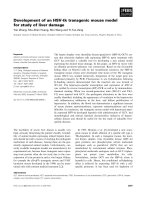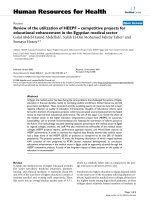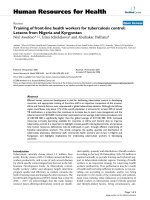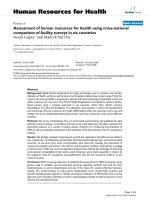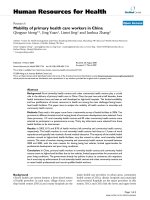Báo cáo sinh học: " Development of an improved microneutralization assay for respiratory syncytial virus by automated plaque counting using imaging analysis" pdf
Bạn đang xem bản rút gọn của tài liệu. Xem và tải ngay bản đầy đủ của tài liệu tại đây (475.58 KB, 5 trang )
BioMed Central
Page 1 of 5
(page number not for citation purposes)
Virology Journal
Open Access
Methodology
Development of an improved microneutralization assay for
respiratory syncytial virus by automated plaque counting using
imaging analysis
Edyta Zielinska, Daiqing Liu, Hong-Yin Wu, Jorge Quiroz, Ruth Rappaport
and Da-Ping Yang*
Address: Clinical Immunology and Virology, Wyeth Vaccines Research, Pearl River, NY. USA
Email: Edyta Zielinska - ; Daiqing Liu - ; Hong-Yin Wu - ;
Jorge Quiroz - ; Ruth Rappaport - ; Da-Ping Yang* -
* Corresponding author
Abstract
Background: Respiratory syncytial virus (RSV) is the major cause of lower respiratory tract
infection in infants and young children. Although several experimental RSV vaccines are under
investigation, immuno therapy is the only treatment currently available. In assessing the
immunogenicity of various vaccine formulations, a plaque reduction neutralization assay for the
evaluation of RSV neutralizing antibody has been widely used. The method produces reliable
results, but it is tedious and labor intensive as it relies on manual counting by laboratory personnel.
To facilitate evaluation of phase II and phase III vaccine clinical trials, a more rapid, reliable and
efficient neutralization assay is needed.
Results: An improved microneutralization assay for quantifying RSV neutralizing antibodies was
developed using an ImmunoSpot
®
Series I Analyzer (Cellular Technology Ltd., Cleveland, OH) for
automated plaque counting. The method is an improvement of the established classical
microneutralization assay in which immunostained plaques on transparent tissue culture plates are
counted manually under a dissecting microscope. Image analyzer technology allows for fully
automated counting of plaques distributed throughout an entire well. Adjustments, such as the use
of opaque tissue culture plates and the TMB substrate, True Blue™ (KPL, Gaithersburg, MD), were
required to adapt the assay for optimal detection of plaques by the image analyzer. The suitability
and the accuracy of the method for counting RSV plaques were determined by comparative testing
of a reference serum and two control sera by manual and automated counting methods. The results
showed that the two methods were highly correlated (R = 0.9580) and the titers generated by
them were within two-fold.
Conclusion: Our results demonstrate that the semi-automated assay is rapid and reliable. It
provides results within two fold to the classical plaque microneutralization assay and is readily
applied to the evaluation of neutralizing antibody titers in sera obtained from epidemiology or
vaccine clinical trials.
Published: 09 November 2005
Virology Journal 2005, 2:84 doi:10.1186/1743-422X-2-84
Received: 08 June 2005
Accepted: 09 November 2005
This article is available from: />© 2005 Zielinska et al; licensee BioMed Central Ltd.
This is an Open Access article distributed under the terms of the Creative Commons Attribution License ( />),
which permits unrestricted use, distribution, and reproduction in any medium, provided the original work is properly cited.
Virology Journal 2005, 2:84 />Page 2 of 5
(page number not for citation purposes)
Background
Respiratory syncytial virus (RSV) is the most common
form of lower respiratory viral infection affecting infants,
the elderly, and immunocompromised individuals [1]. In
severe cases, it may cause complications ranging from
pneumonia and bronchiolitis to death [2]. While the
most severe outcomes arise in patients with weakened or
underdeveloped immune systems, RSV is also gaining
notoriety as an important player in annual respiratory dis-
ease epidemics among healthy adults [3]. Consequently,
there is an obvious unmet need for an efficacious vaccine.
The development of a vaccine will require intensive eval-
uation of the immune response, which can be expedited
by utilizing automation.
The neutralization assay is one of the most trusted and
widely used methods employed for the detection of virus-
specific neutralizing antibodies [4]. The power of the neu-
tralization assay lies in its ability to detect biologically
active antibodies. While there are many methods that pro-
vide information about different aspects of the immune
response (e.g. cellular immunity, genetic markers, etc.)
the neutralization assay remains a proven indicator of
serological immunity for many viruses. In practice, how-
ever, the plaque neutralization assay is a laborious and
time-consuming procedure, making it less suitable for
testing the large numbers of samples that are obtained in
clinical trials. Here, we demonstrate the utility of a
method that automates the most laborious and subjective
part of the serum neutralization assay – the determination
of plaque number. Our results show good agreement
between the visual and automated high throughput
counting methods for determining RSV serum neutraliza-
tion antibody titers.
These results were presented previously at the VI Interna-
tional Symposium on Respiratory Viral Infections, March
18–21, 2004, Fort Myers, Florida [5]
Results
The data were analyzed by two general criteria: agreement
and equivalence. Fig. 1. displays analysis of agreement
between the two methods by plotting titers counted auto-
matically against those counted manually. Pearson's cor-
relation coefficient was 0.9580. Agreement between the
titers obtained by the two methods was visualized by
inspecting how closely the data spread around the 45-
degree line (dashed line), which in this case, reflects the
value of the correlation coefficient. The analysis indicated
that there is a high level of agreement between the titers
generated by image analysis and the standard plaque
counting method.
By plotting the difference between titer values of each data
pair against the mean of the pair, we quantified the degree
of equivalence for the majority of the data (Fig. 2). In log
4 scale, a measure of 1-log is equivalent to 1 dilution or a
4-fold change. The majority of the data lay within 0.5 log
(or 2-fold) of the mean (Fig. 2) indicating that the two
methods show equivalence within 2-fold.
Additional analysis was performed on the largest subset of
data to determine whether within assay variability would
change when using the improved counting method. We
evaluated all of the tests performed on the lyophilized ref-
erence serum in the presence and absence of complement
and sorted the data by assay, method, and complement
treatment. The range and mean of the replicate tests are
depicted in Fig. 3. The difference in the mean of 136 rep-
licates was less than 0.05 (log 4) between groups sepa-
rated by complement treatment (Table 1). Table 1
indicated that the means and variability of the automatic
and manual count were very similar.
Discussion
The data presented here demonstrate agreement and
equivalence between traditional manual and automated
plaque counting methods for detection of RSV neutraliz-
ing antibody titers. The 180 tests performed in the pres-
ence and absence of complement demonstrate that a wide
range of titers is accurately detectable by both assays. The
automated counting method does not increase the overall
variability of the assay; rather variability was observed to
be slightly lower with the automated method. Further-
more, we established that the two methods generated tit-
ers within 2-fold of each other. A clinically significant
change of titer for an RSV patient is indicated by a 4-fold
increase in titer, indicative of seroconversion [6]. There-
Scatter plot of automatically counted titers versus manually counted titers for each sample test presented in logarithm base 4 scaleFigure 1
Scatter plot of automatically counted titers versus manually
counted titers for each sample test presented in logarithm
base 4 scale. The solid line is the simple linear regression line.
The dotted line indicates the 45-degree line.
Virology Journal 2005, 2:84 />Page 3 of 5
(page number not for citation purposes)
fore, equivalence within 2-fold provides an acceptable
level of confidence for the automated counting method.
The strength of this method is that it combines estab-
lished plaque neutralization procedures with the technol-
ogy of computerized image scanning and analysis. It has
the advantage of providing more efficient and objective
results while automating the most laborious and subjec-
tive aspect of the assay – plaque counting. Results can be
stored as images and plaque counts indefinitely. This
allows for better tracking of raw data, as is now mandated
by federal and international regulatory bodies. Another
important strength of this counting system is that it is
capable of detecting and differentiating plaques of differ-
ent morphology and thus can be used to assay many dif-
ferent viruses. In fact, we have already verified the
capability of this system to read plaques created by
mumps, influenza and other viruses (data not shown)
whether in the context of determining viral potency or
performing neutralization assays.
With the technological advances now available, the speed
of plate scanning can be reduced further from 15 minutes/
plate to approximately 2 minutes/plate. Robotic automa-
tion of plate loading can be introduced for further effi-
ciency. The utilization of the TMB substrate staining also
facilitates conservation of primary and secondary anti-
body stocks, which is an important factor when using
viruses for which specific antibodies are not readily or
commercially available. The objectivity and efficiency
provided by this method of plaque counting facilitates the
determination of RSV neutralizing antibody titers and can
be readily applied to human epidemiology and vaccine
clinical studies.
Conclusion
In this report, we describe an RSV microneutralization
assay that relies on automated plaque counting and pro-
vides a more rapid and less laborious method for detect-
ing neutralizing antibodies to RSV. It provides equivalent
results to the classical plaque neutralization assay and can
be used in epidemiology and vaccine clinical studies.
Materials and methods
Serum samples
Human sera provided by Intergen Bio-Diagnostics (Pur-
chase, NY) and Bioreclamation Inc. (Hicksville, NY), were
tested for anti-RSV antibody titers. Sera were selected and
pooled into 3 groups according to titer. The three groups
consisted of a lyophilized reference serum, prepared
under the auspices of NIAID and two control sera of high
and low titer. An historical in-house control standard,
C587645, was also tested. The reference serum made up
the majority of tests (136 tests), whereas the control sera
were each tested approximately 14 times. These sources of
human sera comprised the specimens evaluated in this
study and were collectively tested 180 times by both
methods, in the presence and absence of complement.
Difference-mean plot shows the difference of means in log 4 scaleFigure 2
Difference-mean plot shows the difference of means in log 4
scale. The four populations of data grouped across the cen-
tral line represent (from left to right) the low titer control
serum, the reference serum tested without compliment, the
reference serum tested with complement, and the high con-
trol serum group. The y-axis is represented in log4 scale the
majority of the data lying within 0.5 log.
Boxplots of RSV reference serum titers with and without complement separated by counting methodsFigure 3
Boxplots of RSV reference serum titers with and without
complement separated by counting methods. Open "o" rep-
resents manually counted titers and "*" represents automati-
cally counted titers. For each group of data, the line drawn
through the boxes represents the group mean; the top and
bottom lines of the box represent the 25
th
and 75
th
percen-
tiles; the brackets represent the 95
th
percentile.
Virology Journal 2005, 2:84 />Page 4 of 5
(page number not for citation purposes)
Virus and cells
The A2 strain of RSV was used as the challenge virus in all
tests. Vero cells (ATCC Cat #CCL 34, ATCC, Rockville,
MD) were cultured in EMEM with L-glutamine, 10% FBS,
1% of antibiotic/antimycotic, and non-essential amino
acids. Cells were cultured on 96-well white opaque tissue
culture plates (BD Falcon, Bedford, MA) for automated
counting and on transparent 96-well plates (Corning-Cos-
tar, Corning, NY) for manual plaque counting 1–3 days
prior to infection.
Determination of RSV antibody titers
Microneutralization
Serum samples were heat-inactivated at 56°C for 30 min-
utes. Four-fold serial dilutions from 1:10 to 1:10,240 were
prepared in virus diluent (EMEM with L-glutamine con-
taining 2% FBS, 2.5% HEPES (1 M) and 1% antibiotic/
antimycotic, 100×). All sera were tested in the presence
and absence of 10% guinea pig complement (Cambrex/
BioWhittaker, Walkersville, MD) which was added to the
virus diluent prior to the addition of challenge virus. Seri-
ally diluted serum was challenged with an equal volume
of the RSV-A2 strain, previously titered to give 50–100 pfu
per 50 µl of inoculum. The serum/virus mixtures were
incubated at 37°C, 5% CO
2
for 1 h.
Vero cell monolayers, prepared in 96 well plates, were
infected with 50 µl/well (in duplicate) of the serum/virus
mixture. Plates were centrifuged at 1 h at 2000 rpm (700
g), followed by 30 min of rocking at room temperature.
Supernatants were decanted. Plates were blotted and over-
laid with 0.75% methyl cellulose (4,000 cP at 2% aque-
ous), prepared in MEM with 2% FBS, warmed to 37°C
and inoculated at 100 µl/well. Plates were incubated at
37°C, 5% CO
2
for 3 days to allow for plaque formation.
Conventional staining and plaque determination for RSV
neutralization
Cells infected on transparent plates were fixed with a
50%:50% methanol:ethanol mixture at room tempera-
ture for 10 min. Plates were washed with DPBS after fixing
and between staining steps. Plates were incubated for 1 h
at 37°C, 5% CO
2
with 50 µl/well of monoclonal antibody
specific for RSV-A2 F-protein (Wyeth K6-5-1) diluted to
1:1,000 in Blotto (5% non-fat milk in PBS). Peroxidase
labeled secondary goat anti-mouse IgG antibody (KPL,
Gaithersburg, MD) diluted 1:100 in Blotto, was incubated
at 50 µl/well for 1 h at room temperature. Plaques were
developed using 100 µl/well 3,3'diaminobenzidine HRP
substrate (0.5 mg/ml DAB, 0.01% H
2
O
2
) prepared in
DPBS and incubated at room temperature for 5 – 10 min-
utes. Plates were washed with tap water to stop the reac-
tion.
Plaques were counted manually by inverting the transpar-
ent plate under a dissecting microscope. The field of the
well was separated into quadrants for ease of counting.
Overlapping plaques were deemed individual when lobes
were apparent.
TMB staining and plaque determination for RSV neutralization
Cells infected on opaque white tissue culture plates were
fixed and washed as described above. Plates were incu-
bated for 1 h at 37°C 5% CO
2
with 50 µl/well of mono-
clonal antibody specific for RSV-A2 F-protein (Wyeth, K6-
5-1) diluted to 1:10,000 in blotto. Peroxidase labeled sec-
ondary goat anti-mouse IgG antibody (KPL, Gaithersburg,
MD) diluted 1:3,000 in Blotto was added at 50 µl/well
and incubated for 1 hour at room temperature. Plaques
were developed using 50 µl/well of a ready to use TMB
precipitate HRP substrate, True Blue™ (KPL, Gaithersburg,
MD). Higher dilutions of primary and secondary anti-
body were used due to the increased sensitivity of the per-
oxidase TMB substrate. Plates were washed thoroughly
with tap water to stop the reaction and dried inverted in
order to minimize bleaching.
Plates were scanned and counted by the ImmunoSpot
®
Image analyzer from Cellular Technology Ltd. (Cleveland,
OH). The software, initially designed for use in ELISPOT
analysis, has been successfully employed here for plaque
detection and counting. Overlapping plaques were sepa-
rated using a separation tolerance parameter set by the
experimenter (Fig. 4). Minimum plaque size and sensitiv-
Table 1: Summary of reference serum titers in logarithm base 4 scale.
Complement Counting
Method
Mean Titer Standard
Deviation
Minimum Maximum Number
With Manual 5.02 0.215 4.65 6.01 136
Automatic 4.97 0.204 4.41 5.69 136
Without Manual 4.21 0.297 3.67 5.15 136
Automatic 4.17 0.276 3.56 5.11 136
Publish with BioMed Central and every
scientist can read your work free of charge
"BioMed Central will be the most significant development for
disseminating the results of biomedical research in our lifetime."
Sir Paul Nurse, Cancer Research UK
Your research papers will be:
available free of charge to the entire biomedical community
peer reviewed and published immediately upon acceptance
cited in PubMed and archived on PubMed Central
yours — you keep the copyright
Submit your manuscript here:
/>BioMedcentral
Virology Journal 2005, 2:84 />Page 5 of 5
(page number not for citation purposes)
ity to stain comprised the major parameters that could be
adjusted for counting. Parameters were adjusted on each
experimental day, if necessary.
Calculation of antibody titer
Titer was calculated from the average of duplicate sample
wells by extrapolating the inverse dilution of serum that
produced a 60% reduction of virus according to the fol-
lowing formula:
X = (a-b)(e-c)/(c-d) + a
where, a = log
10
of dilution above the 60% reduction
point, b = log
10
of dilution below the 60% reduction
point, c = average plaque count above the 60% reduction
point (corresponds with a), d = average plaque count
below the 60% reduction point (corresponds with b) and
e = value of 60% reduction of average virus control count.
Statistical analysis
All titers were reported in logarithm base 4 scale in order
to visually represent a difference of one dilution (of a 4-
fold dilution series) as 1 log unit. Different statistical anal-
yses were performed to assess the agreement of titers gen-
erated by two methods. In one analysis we graphically
inspected the spread of the paired titers about the 45° line
and computed Pearson's correlation coefficient. In
another analysis, we determined the level of equivalence
between the two assays, by constructing a difference-
means plot [7].
Competing interests
The author(s) declare that they have no competing inter-
ests.
Authors' contributions
Design and conception of the study and co-drafted the
manuscript (DPY); development of the methods and co-
drafted the manuscript (EZ); assisted in the development
of the automated plaque counting method (DL, HYW);
statistical analysis of the data (JQ); manuscript prepara-
tion and review (RR). All authors read and approved the
final manuscript.
References
1. Collins PL, Chanock RM, Murphy BR: Respiratory syncytial virus. In
In Fields Virology Volume 1. 4th edition. Edited by: Knipe DM, Howley
PM. Philadelphia: Lippincott Williams and Wilkins; 2001:1443-1485.
2. Han LL, Alexander JP, Anderson LJ: Respiratory syncytial virus
pneumonia among the elderly: an assessment of disease bur-
den. J Infect Dis 1999, 179:25-30.
3. Zambon M, Stockton JD, Clewley JP, Fleming DM: Contribution of
influenza and respiratory syncytial virus to community cases
of influenza-like illness: an observational study. Lancet 2001,
358:1410-1416.
4. Casals J: Immunological techniques for animal viruses. In
Methods in Virology Volume III. Edited by: Maramorosch K, Koprowski
H. Academic Press, New York; 1967:113-194.
5. Zielinska E, Liu D, Wu H, Quiroz J, Rappaport R, Yang DP: A novel
high throughput microneutralization assay for respiratory
syncytial virus using an ImmuneSpot Analyzer. [Abstract].
VI International Symposium on Respiratory Vial Infections, March 18–21,
2004, Fort Myers, Florida .
6. Piedra PA, Jewell AM, Cron SG, Atmar RL, Glezen WP: Correlates
of immunity to respiratory syncytial virus (RSV) associated-
hospitalization: establishment of minimum protective
threshold levels of serum neutralizing antibodies. Vaccine
2003, 21:3479-3482.
7. Bland JM, Altman DG: Statistical methods for assessing agree-
ment between two methods of clinical measurement. Lancet
:307-310. 1986 8 Feb
Vero cells infected with RSV-A2 virus and stained with True Blue™ peroxidase substrateFigure 4
Vero cells infected with RSV-A2 virus and stained with True
Blue™ peroxidase substrate. The image shows an example of
plaque differentiation by automated counting. Each "x" repre-
sents one plaque counted by the image analyzer.
